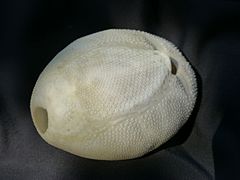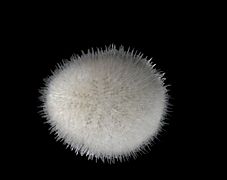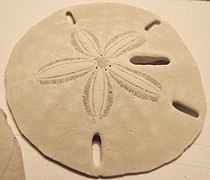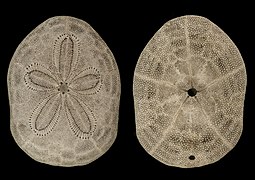Irregularia
Appearance
| Irregularia Temporal range:
| |
|---|---|
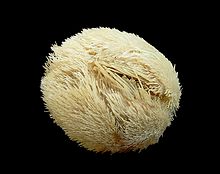
| |
| Echinocardium cordatum | |
| Scientific classification | |
| Domain: | Eukaryota |
| Kingdom: | Animalia |
| Phylum: | Echinodermata |
| Class: | Echinoidea |
| Subclass: | Euechinoidea |
| Infraclass: | Irregularia Latreille, 1825 |
| Superorders | |
Irregularia is an
extant infraclass of sea urchins that first appeared in the Lower Jurassic
.
Description and characteristics
These particular sea urchins are distinguished from other sea urchins by their irregular shape: the anus and often even the mouth are at the two poles of the test, creating a bilateral symmetry instead of the classical 5-fold symmetry of
sea biscuits
and some other forms. Most of them live inside the sediment, moving in thanks to their particular spines, and feed on its organic fraction.
-
Test of a spatangoid (oral face): the mouth is on the right and the anus on the left.
-
Test of a Mellita quinquiesperforata.
-
A "sand dollar" in its environment.
-
Clypeaster reticulatus (family Clypeasteridae).
-
Encope emarginata (aboral and oral faces) drawn by Ernst Haeckel (1904).
-
Clypeaster rosaceus, ibid.
-
Many slices of a Clypeaster aegypticus, showing buttresses and pillars.
Taxonomy
Hemipneustes pyrenaicus (Holasteroida
).
Clypeasteroida
). 

- super-order Atelostomata
- fossil family Acrolusiidae Mintz, 1968 †
- fossil family Collyritidae d'Orbigny, 1853 †
- fossil family Disasteridae Gras, 1848 †
- order Holasteroida
- order Spatangoida
- fossil family Tithoniidae Mintz, 1968 †
- fossil genus Atlasaster Lambert, 1931 †
- fossil family Desorellidae Lambert, 1911a †
- order Echinoneoida
- fossil family Galeropygidae Lambert, 1911a †
- fossil genus Grasia Michelin, 1854 †
- fossil order Holectypoida †
- fossil family Menopygidae Lambert, 1911 †
- fossil genus Mesodiadema Neumayr, 1889 †
- super-order Neognathostomata
- familia Apatopygidae Kier, 1962
- fossil family Archiaciidae Cotteau & Triger, 1869 †
- order Cassiduloida
- order Clypeasteroida
- fossil family Clypeidae Lambert, 1898 †
- fossil family Clypeolampadidae Kier, 1962 †
- order Echinolampadoida
- fossil family Nucleolitidae L. Agassiz & Desor, 1847 †
- fossil family Pygaulidae Lambert, 1905 †
- fossil genus Pygolampas Saucède, Dudicourt & Courville, 2012 †
- fossil order Oligopygoida Kier, 1967 †
- fossil family Pygasteridae Lambert, 1900 †
- fossil family Pygorhytidae Lambert, 1909b †
References
- Barnes, Robert D. (1982). Invertebrate Zoology. Philadelphia, PA: Holt-Saunders International. p. 981. ISBN 0-03-056747-5.
- Kroh A, Mooi R (eds.). "Irregularia". World Echinoidea Database. World Register of Marine Species.

